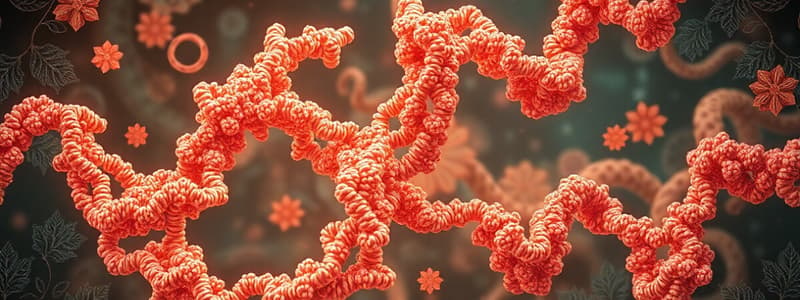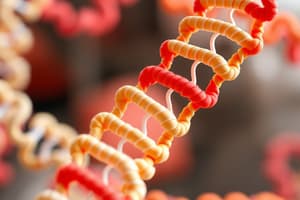Podcast
Questions and Answers
What is the primary function of translation in DNA?
What is the primary function of translation in DNA?
- To store genetic information
- To repair damage in DNA
- To replicate the DNA strand
- To synthesize proteins (correct)
Which molecule is primarily responsible for carrying the information from DNA to the site of protein synthesis?
Which molecule is primarily responsible for carrying the information from DNA to the site of protein synthesis?
- Transfer RNA
- Deoxyribonucleic acid
- Messenger RNA (correct)
- Ribosomal RNA
During translation, which cellular structure is responsible for assembling amino acids into a polypeptide chain?
During translation, which cellular structure is responsible for assembling amino acids into a polypeptide chain?
- Endoplasmic reticulum
- Ribosome (correct)
- Lysosome
- Nucleus
What process occurs before translation can begin?
What process occurs before translation can begin?
What role do transfer RNA (tRNA) play during translation?
What role do transfer RNA (tRNA) play during translation?
Flashcards are hidden until you start studying
Study Notes
Translation's Role in DNA
- Translation is the process that converts the genetic information encoded in DNA into proteins.
- It's a critical step in gene expression; DNA's instructions are transformed into functional molecules.
Messenger RNA: The Information Carrier
- Messenger RNA (mRNA) carries the genetic information from DNA to the ribosomes.
- Ribosomes are the sites of protein synthesis.
- mRNA acts as a blueprint, guiding the assembly of amino acids into a specific protein sequence.
Ribosomes: Protein Assembly Sites
- Ribosomes are the cellular structures responsible for assembling amino acids into polypeptide chains.
- They read the mRNA sequence and use it to select the correct amino acids.
- These amino acids are linked together, forming a polypeptide chain, which eventually folds to create a functional protein.
Transcription: Precursor to Translation
- Transcription is the process that precedes translation.
- It involves copying the DNA sequence into an mRNA molecule.
- This mRNA molecule then serves as a template for protein synthesis during translation.
Transfer RNA: The Amino Acid Carriers
- Transfer RNA (tRNA) molecules play a crucial role in translation.
- Each tRNA molecule binds to a specific amino acid and carries it to the ribosome.
- tRNA molecules have a special region called an anticodon, which recognizes and binds to a complementary codon on the mRNA molecule.
- This ensures that the correct amino acid is added to the growing polypeptide chain.
Studying That Suits You
Use AI to generate personalized quizzes and flashcards to suit your learning preferences.




